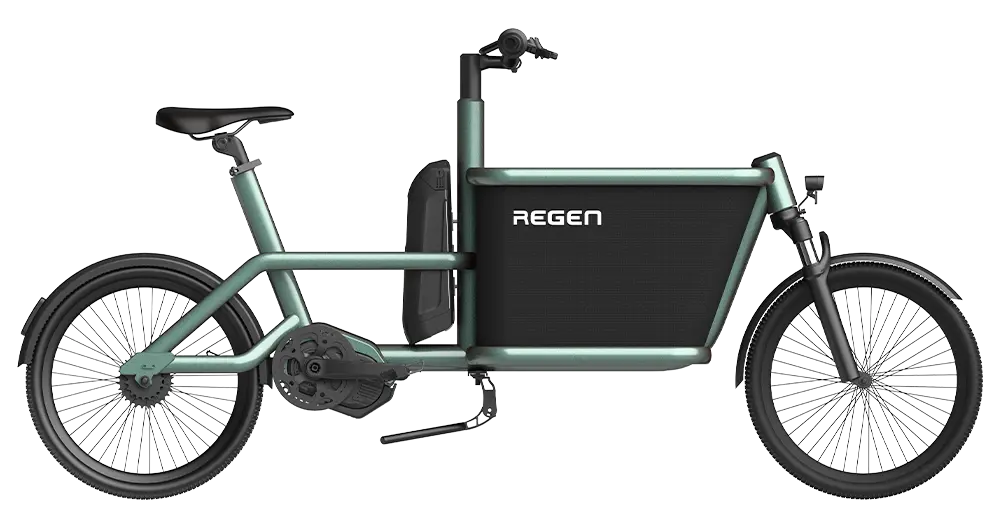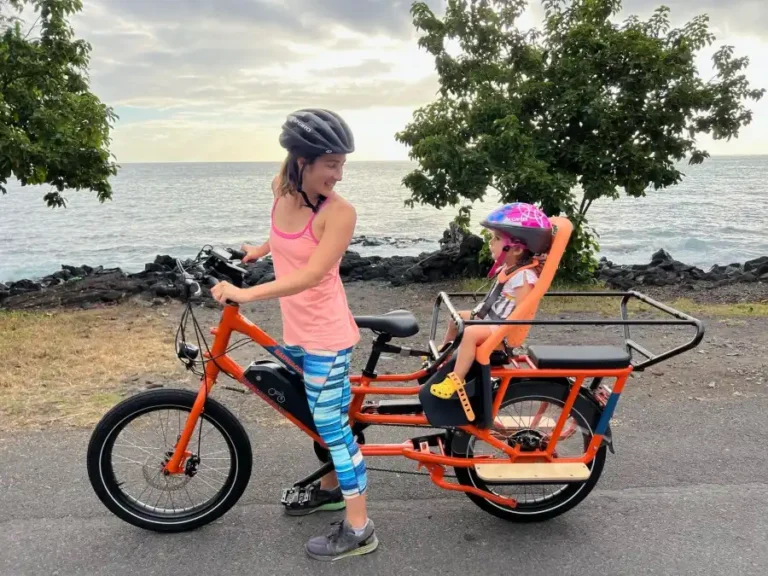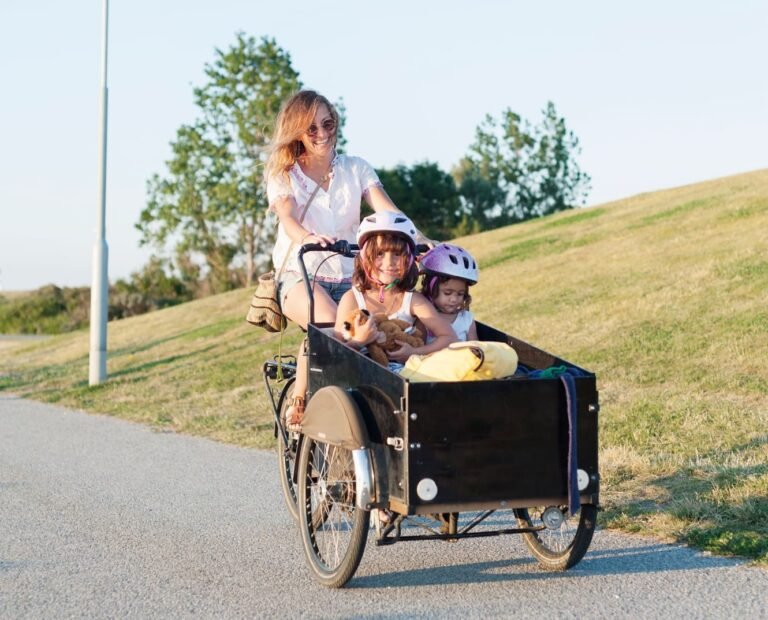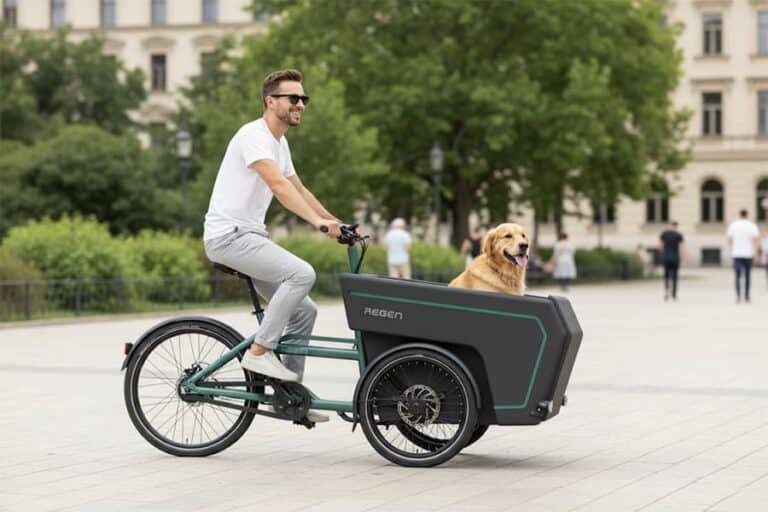Στην Regen, σχεδιάζουμε και κατασκευάζουμε καθημερινά ποδήλατα φορτίου με εμπρόσθιο φορτίο. Και αν υπάρχει ένα μοντέλο που εμφανίζεται συνεχώς σε συζητήσεις με αστικές οικογένειες, ταχυμεταφορείς τελευταίου χιλιομέτρου και επιχειρήσεις με οικολογική συνείδηση - είναι το Ποδήλατο φορτίου Long John. Αυτό το στυλ ποδηλάτου φορτίου είναι τόσο εικονικό όσο και εξαιρετικά λειτουργικό. Με πάνω από έναν αιώνα εξέλιξης, παραμένει κορυφαία επιλογή για όσους επιθυμούν να μεταφέρουν περισσότερα χωρίς να βασίζονται σε αυτοκίνητα.
Σε αυτόν τον οδηγό, θα θέλαμε να μοιραστούμε μαζί σας τι είναι το ποδήλατο φορτίου Long John, από πού προέρχεται, τι το κάνει ξεχωριστό και γιατί εμείς στο Regen πιστεύουμε ότι είναι ένα πρακτικό, κομψό και βιώσιμο όχημα για τις πόλεις του αύριο.
Αν είστε νέοι στα ποδήλατα φορτίου, σας προτείνουμε να ξεκινήσετε με το iΕισαγωγικός οδηγός: "Τι είναι το ποδήλατο φορτίου;". Θα σας δώσει μια σαφή επισκόπηση των διαφόρων τύπων (συμπεριλαμβανομένων των ποδηλάτων Long John), για ποιο λόγο χρησιμοποιούνται και γιατί έχουν σημασία στις σημερινές πόλεις.
Σύντομη ιστορία του ποδηλάτου μεταφοράς φορτίου Long John
Το ποδήλατο φορτίου Long John έχει τις ρίζες του πίσω στο Η Κοπεγχάγη τη δεκαετία του 1920. Το πρώτο "Long John" δημιουργήθηκε από τον Δανό εφευρέτη Morten Rasmussen Mortensen το 1923 με την επωνυμία SCO (Smith & Co). Διαθέτει ένα χαμηλό πλαίσιο με μπροστινή πλατφόρμα φόρτωσης που βρίσκεται μεταξύ του τιμονιού και του μπροστινού τροχού, το οποίο καθοδηγείτο μέσω ενός συστήματος σύνδεσης. Αυτός ο σχεδιασμός αποτέλεσε ακρογωνιαίο λίθο της αστικής ζωής της Δανίας για δεκαετίες.
Μέχρι τα μέσα του 20ου αιώνα, τα Long Johns ήταν πανταχού παρόντα στη Βόρεια Ευρώπη, τα οποία χρησιμοποιούσαν οι ταχυδρομικοί υπάλληλοι, οι αρτοποιοί και οι ανθοπώλες. Ωστόσο, με την άνοδο των αυτοκινήτων και των φορτηγών, η δημοτικότητά τους μειώθηκε τη δεκαετία 1970-1990.
Τα τελευταία χρόνια, με την αναζωπύρωση της αστικής ποδηλατικής κουλτούρας, τις προσπάθειες βιωσιμότητας και τις ανάγκες παράδοσης του τελευταίου χιλιομέτρου, το Long John έχει κάνει μια ισχυρή επιστροφή - ειδικά με τη μορφή του ποδήλατα Long John με ηλεκτρική υποβοήθηση. Στο Regen, βλέπουμε αυτό το μοντέλο όχι απλώς ως ένα νοσταλγικό σχέδιο, αλλά ως μια σύγχρονη λύση εφοδιαστικής και τρόπου ζωής.
Σχετική ανάγνωση: ιστορία των ποδηλάτων φορτίου : το χρονοδιάγραμμα
Τι ακριβώς είναι το ποδήλατο φορτίου Long John;
ΕΝΑ Ποδήλατο φορτίου Long John είναι μια τύπου ποδήλατο φορτίου με εμπρόσθια φόρτωση χαρακτηρίζεται από:
- ΕΝΑ χαμηλό, επιμήκες πλαίσιο που τοποθετεί το χώρο φόρτωσης μεταξύ του αναβάτη και του μπροστινού τροχού.
- ΕΝΑ σύνδεσμος μηχανισμού διεύθυνσης, επιτρέποντας στον μπροστινό τροχό να περιστρέφεται παρόλο που είναι τοποθετημένος πολύ μπροστά από το τιμόνι.
- Δύο τροχοί-μία πίσω και μία μπροστά- με αποτέλεσμα ένα μακρύ μεταξόνιο που ενισχύει τη σταθερότητα.
- ΕΝΑ πλατφόρμα ή κιβώτιο φορτίου, τα οποία μπορούν να είναι ανοικτά για εμπορεύματα ή κλειστά για τη μεταφορά παιδιών, κατοικίδιων ζώων ή εξοπλισμού.
Σκεφτείτε το σαν ένα φορτηγό με δύο τροχούς - αλλά πολύ πιο ευέλικτο, πιο αθόρυβο και με μηδενικές εκπομπές ρύπων.

Regen 02 Ποδήλατο Ηλεκτρικού Φορτίου
Ψάχνετε για ένα συμπαγές, προσαρμόσιμο εμπρόσθιο φορτωτή για την επωνυμία σας;
Δοκιμασμένο από την TÜV μέσω προηγούμενων προσαρμοσμένων έργων. Δημόσια διαθέσιμο μοντέλο—διαμορφώσιμο, δοκιμασμένο και έτοιμο για κλιμάκωση.
Ανατομία ενός ποδηλάτου φορτίου Long John (ανάλυση δομής)
Το ποδήλατο φορτίου Long John χαρακτηρίζεται από μια μοναδική διάταξη πλαισίου και σύστημα διεύθυνσης που το διαφοροποιεί από τα άλλα ποδήλατα κοινής ωφέλειας. Ο σχεδιασμός του επιτρέπει την εμπρόσθια φόρτωση φορτίου χωρίς να διακυβεύεται η ισορροπία, η ευελιξία ή η άνεση του αναβάτη. Ακολουθεί μια λεπτομερής ανάλυση των δομικών συστατικών του:
1. Διευρυμένη γεωμετρία πλαισίου
Στον πυρήνα του σχεδιασμού του Long John είναι η μακρόστενο πλαίσιο, το οποίο τοποθετεί τον μπροστινό τροχό πολύ μπροστά από τον αναβάτη, με ένα πλατφόρμα ή κιβώτιο φορτίου που βρίσκεται μεταξύ του τιμονιού και του μπροστινού άξονα. Αυτή η εκτεταμένη γεωμετρία αυξάνει το μεταξόνιο του ποδηλάτου, βελτιώνοντας τη σταθερότητα στην ευθεία και κατανέμοντας το βάρος πιο ομοιόμορφα στο πλαίσιο.
Η μπροστινή περιοχή φόρτωσης είναι συνήθως ενσωματωμένη σε ένα άκαμπτο υποπλαίσιο ενισχυμένο με πρόσθετα εγκάρσια μέλη και δικτυώματα. Τα περισσότερα σύγχρονα Long Johns κατασκευάζονται με χρήση υψηλής αντοχής σε εφελκυσμό κράματα αλουμινίου (π.χ. 6061-T6) ή χρωμολυβδαινός χάλυβας (π.χ. 4130 CrMo) για την εξισορρόπηση της ακαμψίας, του βάρους και της ανθεκτικότητας.
2. Πλατφόρμα ή κιβώτιο φορτίου
Βρίσκεται μεταξύ του αναβάτη και του μπροστινού τροχού και μπορεί να σχεδιαστεί ως εξής:
- Επίπεδη ή σχάρα: Για προσαρμόσιμη πρόσδεση φορτίου.
- Ξύλινο ή σύνθετο κουτί: Συχνά με ενσωματωμένα παιδικά καθίσματα, ιμάντες και αδιάβροχα καλύμματα.
- Εμπορικά περιβλήματα: Για logistics ή παράδοση τροφίμων.
Οι διαστάσεις και η χωρητικότητα φορτίου ποικίλλουν, αλλά τα περισσότερα είναι σχεδιασμένα για να μεταφέρουν 70-100 κιλά φορτίου μόνο στο μπροστινό μέρος, με πρόσθετη χωρητικότητα στην πίσω σχάρα ή στη βάση της σέλας.
3. Μηχανισμός διεύθυνσης συνδέσμου
Μια βασική δομική καινοτομία των ποδηλάτων Long John είναι το σύστημα διεύθυνσης με σύνδεσμο, το οποίο συνδέει το τιμόνι με το μπροστινό πιρούνι μέσω μιας σειράς ράβδων ή καλωδίων. Δεδομένου ότι ο μπροστινός τροχός βρίσκεται πέρα από τον άμεσο άξονα του τιμονιού, αυτό ρύθμιση απομακρυσμένου τιμονιού επιτρέπει τον έλεγχο με απόκριση παρά το μακρύ πλαίσιο.
Τα βασικά στοιχεία περιλαμβάνουν:
- Ράβδος(-ες) τιμονιού με περιστρεφόμενες αρθρώσεις
- Βραχίονας τιμονιού τοποθετημένο στο πιρούνι ή στο ακουστικό
- Αρθρώσεις μπάλας ή αρθρώσεις Heim για να επιτρέπει την ομαλή γωνιακή κίνηση
Τα υψηλής ποιότητας συστήματα συνδέσμων είναι βελτιστοποιημένα ώστε να εξαλείφεται το παιχνίδι ή η υστέρηση, διατηρώντας την ακρίβεια ακόμη και υπό φορτίο ή σε ανώμαλο έδαφος.
4. Συναρμολόγηση κεφαλόδεσμου και μπροστινού πιρουνιού
Ο headtube είναι συχνά πιο απότομη από ό,τι στα συμβατικά ποδήλατα (περίπου 68-75 βαθμούς) για να διασφαλιστεί η απόκριση του χειρισμού. Το μπροστινό πιρούνι πρέπει να είναι μακρύτερα από το κανονικό, ικανά να υποστηρίζουν δισκόφρενα, μπροστινό φωτισμό και περιστασιακά, ανάρτηση.
Ορισμένα προηγμένα σχέδια διαθέτουν πιρούνια ανάρτησης (αέρας ή πηνίο) με Διαδρομή 80-100 mm, ιδίως στις ηλεκτρικές εκδόσεις που μεταφέρουν εύθραυστο ή ζωντανό φορτίο.
5. Σύστημα κίνησης και σύστημα μετάδοσης κίνησης
Ενώ τα παραδοσιακά Long Johns ήταν μόνο με πεντάλ, οι σύγχρονες εκδόσεις έρχονται συχνά με συστήματα ηλεκτρικής υποβοήθησης (ποδήλατα e-cargo) που διαθέτουν:
- Κινητήρες μεσαίας κίνησης για καλύτερη κατανομή βάρους και μεταφορά ροπής.
- Εξωτερικοί ή εσωτερικοί οδοντωτοί τροχοί (π.χ., Shimano Alfine, Enviolo) για μετατόπιση με χαμηλή συντήρηση υπό φορτίο.
- Τεντωτήρες αλυσίδας ή αδρανοποιητές για να φιλοξενήσει το μακρύ μήκος της αλυσίδας που προκύπτει από το εκτεταμένο πλαίσιο.
Το σύστημα μετάδοσης κίνησης είναι τυπικά μονόμπροσθεν και πολλαπλά οπίσθιο, αλλά ιμάντα κίνησης χρησιμοποιούνται όλο και περισσότερο για ανθεκτικότητα και χαμηλότερη συντήρηση.
6. Σύστημα πέδησης
Δεδομένου του πρόσθετου βάρους και της αδράνειας, η ισχυρή πέδηση είναι ζωτικής σημασίας. Οι περισσότεροι Long Johns χρησιμοποιούν:
- Υδραυλικά δισκόφρενα με μεγάλους ρότορες (180-203 mm)
- Δαγκάνες διπλού ή τετραπλού εμβόλου
- Φρένα στάθμευσης ενσωματωμένο στο μοχλό ή στο πίσω σύστημα για την ασφάλιση του ποδηλάτου όταν είναι σταθερό
Ορισμένα συστήματα περιλαμβάνουν αισθητήρες διακοπής κινητήρα σε εκδόσεις για ηλεκτρονικά ποδήλατα για πρόσθετη ασφάλεια.
7. Διαμόρφωση μεγέθους τροχού
Η πλειονότητα των ποδηλάτων Long John χρησιμοποιεί μικτά μεγέθη τροχών για την εξισορρόπηση του όγκου φορτίου και των επιδόσεων οδήγησης:
- Μπροστινός τροχός: 20-24 ίντσες για χαμηλότερο κέντρο βάρους και απόσταση από το φορτίο
- Πίσω τροχός: 26-28 ίντσες για βελτιωμένη απόδοση του συστήματος μετάδοσης κίνησης και άνεση του αναβάτη
Αυτή η διαμόρφωση επιτρέπει ένα χαμηλό χώρο φόρτωσης χωρίς να διακυβεύεται η εργονομία του πεντάλ.
8. Αξεσουάρ και ενσωμάτωση ειδικά για το φορτίο
Η διαρθρωτική ολοκλήρωση συχνά περιλαμβάνει:
- Ράγες τοποθέτησης για καθίσματα ή συστήματα θόλων
- Ενσωματωμένος φωτισμός και ανακλαστήρες συμμόρφωση με τους τοπικούς νόμους περί κυκλοφορίας
- Kickstands σχεδιασμένα για σταθερότητα υπό βαρύ φορτίο (συχνά με διπλό πόδι ή ευρύ κατάστρωμα)
- Βάσεις πλαισίου για παιδικά συστήματα συγκράτησης ή συμβατότητα ISOFIX
Οι επαγγελματικές και βιομηχανικές εκδόσεις μπορεί να περιλαμβάνουν κλειδώσιμα διαμερίσματα αποθήκευσης, θερμική μόνωση, ή επιφάνειες επωνυμίας.
Κοινές εφαρμογές των ποδηλάτων φορτίου Long John
Στην Regen, συνεργαζόμαστε με πελάτες από ένα ευρύ φάσμα βιομηχανιών - και οι Long Johns είναι συχνά ο πρωταγωνιστής της παράστασης. Ορισμένες τυπικές περιπτώσεις χρήσης περιλαμβάνουν:
Οικογενειακές μεταφορές
Με παιδικά καθίσματα, παραγεμισμένα κιβώτια και καλύμματα για τις καιρικές συνθήκες, τα Long Johns κάνουν τη σχολική διαδρομή ξανά διασκεδαστική. Τα παιδιά λατρεύουν το κάθισμα στην πρώτη σειρά και οι γονείς λατρεύουν την ασφάλεια και την ευκολία.

Αστική παράδοση τελευταίου μιλίου
Από δέματα μέχρι διανομή τροφίμων, το Long John είναι ιδανικό για την πλοήγηση στην κυκλοφορία ενώ μεταφέρει βαριά φορτία. Οι επιχειρήσεις εκτιμούν την εξοικονόμηση χώρου επωνυμίας και κόστους οχήματος.
Επαγγέλματα και υπηρεσίες
Έχουμε κατασκευάσει μοντέλα για υδραυλικούς, ηλεκτρολόγους και ομάδες συντήρησης που πρέπει να μεταφέρουν εργαλεία σε πυκνές αστικές περιοχές, όπου τα φορτηγά δυσκολεύονται.
Πράσινη εφοδιαστική
Οι δήμοι τα χρησιμοποιούν για τη συντήρηση πάρκων, την αποκομιδή απορριμμάτων, ακόμη και για την πώληση προϊόντων στους δρόμους σε ζώνες χαμηλών εκπομπών.
Γιατί να επιλέξετε ένα ποδήλατο φορτίου Long John;
Μπορεί να αναρωτηθείτε: γιατί δεν χρησιμοποιείτε απλώς ένα αυτοκίνητο ή ένα ποδήλατο με ρυμουλκούμενο; Ακολουθούν οι λόγοι για τους οποίους εμείς και οι πελάτες μας επιλέγουμε σταθερά τη Long Johns.
Αστική ευελιξία με μικρό αποτύπωμα
Παρά το μακρύ πλαίσιο, αυτά τα ποδήλατα είναι εκπληκτικά ευέλικτη. Στο Regen, σχεδιάζουμε συμπαγή Long Johns (όπως τα Regen 02) με ένα μικρή ακτίνα στροφής, καθιστώντας τα ιδανικά για μικρά σοκάκια και γωνιές της πόλης.
Σταθερό και ασφαλές
Το χαμηλό κέντρο βάρους και το μακρύ μεταξόνιο προσφέρουν απαράμιλλο ισορροπία και έλεγχος, ειδικά όταν μεταφέρουν ζωντανό φορτίο όπως παιδιά ή κατοικίδια ζώα.
Εξαιρετικά προσαρμόσιμο
Από προσαρμοσμένα χρώματα και λογότυπα μέχρι τύπους κουτιών φορτίου, τα Long Johns είναι ειδικά σχεδιασμένο για την προβολή της μάρκας και πρακτικές ανάγκες. Το Regen υποστηρίζει OEM και ODM πελάτες στην Ευρώπη και παγκοσμίως.
Φιλικό προς το περιβάλλον και αποδοτικό
Χωρίς εκπομπές ρύπων, χωρίς κόστος καυσίμων και με λιγότερα προβλήματα στάθμευσης. Ένα ποδήλατο Long John e-cargo είναι ένα έξυπνο βήμα προς την κατεύθυνση βιώσιμη αστική κινητικότητα.
Δημοφιλείς μάρκες ποδηλάτων φορτίου Long John
Θαυμάζουμε και σεβόμαστε πολλά άλλα εμπορικά σήματα που βοήθησαν να διατηρηθεί η Long Johns επίκαιρη. Ακολουθούν μερικά από αυτά που διαμόρφωσαν τη βιομηχανία:
| Μάρκα | Αξιοσημείωτο μοντέλο | Κεντρικά γραφεία |
|---|---|---|
| Λάρι εναντίον Χάρι | Μπούλιτ | Κοπεγχάγη, DK |
| Αστικό Βέλος | Οικογένεια, φορτίο L | Άμστερνταμ, NL |
| Ρίζε και Μίλερ | Φορτίο 75, Packster | Darmstadt, DE |
| Πύκλοι Douze | Σειρά G4 e-cargo | Ντιζόν, FR |
| Regen | Regen 02 | Κίνα + Πορτογαλία |
Στο Regen, εμπνεόμαστε από αυτούς τους πρωτοπόρους, αλλά σχεδιάζουμε με τη δική μας φιλοσοφία: ευέλικτη παραγωγή, συναρμολόγηση στην ΕΕ και τεχνική καινοτομία προσαρμοσμένο για αναπτυσσόμενες μάρκες κινητικότητας.
Γιατί Regen?
Ως ειδικός στα ηλεκτρικά ποδήλατα φορτίου OEM και ODM, εμείς στην Regen έχουμε περάσει χρόνια τελειοποιώντας τα μοντέλα Long John με βάση την εμπειρία του πραγματικού κόσμου, την τεχνογνωσία μηχανικής και τη στενή συνεργασία με τους πελάτες μας.
Κλείνοντας
Το ποδήλατο μεταφοράς φορτίου Long John είναι κάτι περισσότερο από ένα νοσταλγικό δίκυκλο - είναι μια πλατφόρμα κινητικότητας με προοπτική για το μέλλον. Στο Regen, το βλέπουμε ως το τέλειο μείγμα χρησιμότητας, σχεδιασμού και βιωσιμότητας. Είτε είστε κάτοικος της πόλης με δύο παιδιά, είτε μια νεοσύστατη επιχείρηση που ξεκινά μια πράσινη υπηρεσία παράδοσης, είτε μια μάρκα κινητικότητας που αναπτύσσει το επόμενο best-seller σας, σας προσκαλούμε να εξετάσετε το Long John.
Οι μηχανικοί, οι σχεδιαστές και οι σύμβουλοι πωλήσεών μας είναι εδώ για να σας καθοδηγήσουν από σκίτσο στο δρόμο-με τεχνικό βάθος, ευελιξία και βαθιά κατανόηση του τρόπου με τον οποίο τα ποδήλατα φορτίου αλλάζουν τις πόλεις.
Ας φτιάξουμε μαζί το επόμενο Long John.
Αναφορές
- CyclingTips. (2021). Η ιστορία και η αναβίωση των ποδηλάτων φορτίου. Ανακτήθηκε από https://cyclingtips.com
- Αστικό βέλος. (n.d.). Σχετικά με το οικογενειακό μοντέλο. Ανακτήθηκε από https://urbanarrow.com
- Larry εναντίον Harry. (n.d.). Ποδήλατα φορτίου Bullitt. Ανακτήθηκε από https://larryvsharry.com
- Πρότυπο EN 17860. (2022). Απαιτήσεις για ποδήλατα φορτίου. Ευρωπαϊκή Επιτροπή Τυποποίησης.
- Riese & Müller. (n.d.). Ηλεκτρονικά ποδήλατα σειράς Load. Ανακτήθηκε από https://r-m.de






